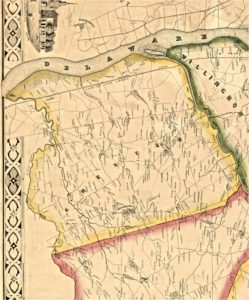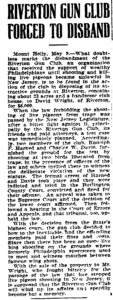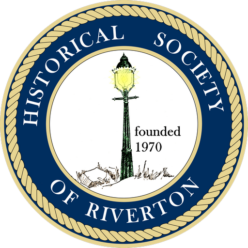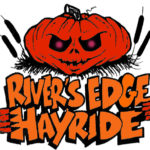Q: What do Riverton Gun Club, a stud bull named Pinochle Prince, a 1990s Halloween hayride, and the Villages at Cinnaminson Harbour have in common?
A: They all occurred at the same place but at different times. Here’s how.
In July 2020, my wife and I moved from Delran to a townhouse in East Riverton, within the Township of Cinnaminson. It’s a stone’s throw from Riverton, just across the Pompeston Creek.

If not for a defeated 1913 bill in the New Jersey Legislature that would have allowed its annexation, East Riverton might have been part of Riverton.
For the history of the early development of Riverton, I refer to three of Betty Hahle’s “Yesterday” columns.

When the founders established the village in 1851, it was a few streets within the larger township of Cinnaminson, which was itself within the much larger township of Chester. Cinnaminson separated from Chester in 1860.
The village grew. In 1877, it added a section from Cottage Ave. to Thomas, from the river to the railroad. The” ‘Thomas Extension” c1882 moved the border down to Elm, and then after 1900, the land above the railroad opened up. Lippincott land began to be developed from the present upper boundaries toward the center of town. (GN 021, Feb 1981)
In December 1893, Riverton separated from Cinnaminson, as a borough. (GN 062, May 1991)

Above the (Pompeston) Creek is East Riverton, largely developed by realtor Charles Price, with the expectation that it would, when developed, become a part of Riverton.

However, in 1913 voters rejected the proposal, and so East Riverton has remained a part of Cinnaminson. Early in this (20th) century, the Riverton Gun Club (RGC) had its grounds along the riverfront there. (GN #088, March 1998)
The competitors at RGC shot live birds; hundreds perished during a typical day of shooting.

In 1904, the NJ Legislature passed a law making it illegal to shoot live birds so two club members decided to test the law’s constitutionality by shooting one in the presence of a constable.
Short story – the club lost.

Pat Brunker catches us up on the disbanding of the club from a newsletter article she wrote on the history of the RGC.
A Special Meeting of the Riverton Gun Club was held at the Club House on July 18, 1906. The club decided to carry out the sale of the Club real estate and the Club property.
All household effects were sold (to David H. Wright), and the amount realized was in the neighborhood of $700. (GN #121, March 2006)
David Wright had opposed the shooting of live birds for sport, and after his purchase of the land, Wright renamed the gun club grounds Peace and Plenty Farm.
Advertisements in The New Era indicate that Wright sold milk and hatching eggs and offered the stud services of Pinochle Prince, a registered bull, for a fee of $5.00.
Wright later sold the farm to Joseph Rieder, who operated a cafe and inn on the premises as the Great Depression loomed. (Online inflation calculators claim that $1 in 1932 had the same purchasing power as $20.71 today.)
Rieder passed in 1932, and presumably, the land passed into the hands of another party. The use of that part of East Riverton for the next few decades is unknown. If a reader knows, please send us details, and we will revise this article.
The next time we hear of use for farmland in that area is for a Halloween hayride that existed from about 1993 to 2005.

The hayride’s days were numbered as Cinnaminson Township held a hearing in 1998 for a proposed development of 1,000 townhomes.
However, construction did not get underway until 2004.
Sales of the initial phase of homes began in January 2005, and the last haunted hayride occurred in October 2005.
It took about a century for suburban sprawl – the spread of urbanized areas into the rural landscape – to overtake what once had been Cinnaminson farmland.
Of course, suburban sprawl can negatively affect the environment. Realize, however, that when those men founded Riverton in 1851, they not only originated “…the first wholly planned residential subdivision in America” – they simultaneously started suburban sprawl.
No doubt, the Lenni-Lenape of the 17th century thought, “There goes the neighborhood,” as European settlers encroached upon the lands they had lived on for 12,000 years.
Finally, this last “show and tell” sprang from my curiosity about how a map of the old gun club might align with a present-day map.


View an 18MB video clip that shows how the Riverton Gun Club location compares to that of Cinnaminson Harbour.









I feel we keep taking g away history which is very important to how our country came about. The kids today don’t know much they have to look it up anymore. I love history and l was able to travel and only missed 8 states and l looked back at how the colonists traveled in harsh weather through all the obstacles. I tell people when they say they are going to the carribiean l tell them rent a rv and see the US in all its glory. There is so much history but we keep making room for progress that there won’t be anything left to show anyone anymore and that’s sad.
Thanks Mr. McC, this is fascinating! I enjoyed seeing the video.
The haunted hayride logo looks really familiar. I’m pretty sure I went once (I’m allergic to hay and scary stuff), but it was a regular thing for my classmates each year.